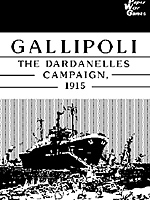 Designer: Rick Spence
Designer: Rick Spence
Publisher: Paper Wars Games, 1979
[Note: Paper Wars Games Co. is not related to the later magazine Paper Wars. -ed]
Players 2
Period World War One
Scale 500 yds (land) / 880 yds (sea)
Turn 6-12 hrs (land) / 20 min (sea)
Unit Battalion (land) / ships (sea)
Components
1 1" cardboard box
3 Unmounted maps on thick paper: 11" x 25˝" (Dardanelles) 17˝" x 26˝" (Sulva Bay & Anzac) 16" x 13" (Cape Helles)
1 30-page rulebook, including historical commentary, designer notes, scenarios, and players notes; errata included.
1 4 page folder of charts & tables
1 Allied Ship and Turkish Fort damage sheets 504 Die-cut, backprinted counters
Paper Wars says:
“Gallipoli is a simulation game dealing with the Anglo-French amphibious assaults on the Gallipoli peninsula in 1915. [T]he game focuses on the landings and their immediate aftermaths. The result is a game which is perhaps more accurate and certainly more interesting than one which tried to cover the campaign to its full length.”
The Reviewer says:
“Overall, the land game system is simple, clean, and effective. The work on the orders of battle is detailed and good. The naval game simulates an atypical war gaming action, an attempt by battleships to force narrows protected by fixed defenses. The game system is well constructed. Rick Spence is to be congratulated on producing a game on a neglected campaign with unusual and interesting situations, for which appropriate and effectiveness mechanics have been devised.” --Petter Hatton in F&M 24.
Comments
Gallipoli is a classic from the Golden Age of wargaming, and deservedly so. For a third world company, Paper Wars stuffed a lot of production and play value into the box. The rules, which are very accessible, are broken into Land and Naval sections. Beachheads, troop disorganization, artillery barrage, evacuations, mines and minesweeping, ship towing, and Allied withdrawal are some of the items covered. The color counters are functional, and the play aids are helpful. The color maps are merely average, somewhat less attractive than what SPI was producing at the time.
There are three naval and three land scenarios included, along with some what if options (e.g, a British armored car unit at Sulva). There is no linked campaign due to scaling differences. The OOB is impressive, with over 80 national units identified. A bibliography is included.
Being a game that covers one of the most compelling campaigns of WWI, a subject that has been virtually untouched by the hobby, Gallipoli would merit attention based on that fact alone.
Yet it is a cohesive design, and as a labor of love for Mr. Spence, it appears he somehow managed to put together an excellent total package.
Collector’s Notes
This is a scarce game, which, when coupled with its solid reputation, means that a high price is always commanded. Whether punched or mint, a range of $125 to $150 is not uncommon.
I have verified at least 4 such sales at this price level within the past 18 months. Boone quotes low, high and average prices of 10/45/27.00 at auction and 20/60/40.00 for sale, which is a reflection of the age of Boone’s data (1999) and Gallipoli no longer being a Berg’s Paradox.
Counter Manifest
113 British army (white on red)
48 Anzac army (black on red)
10 red blanks
20 French army (white on blue)
8 Indian army (red on white)
20 Royal Navy (red on white)
17 Numbered markers (red on white)
4 French Navy (blue on white)
12 Numbered markers (blue on white)
170 Turkish army (white on green)
5 green blanks
5 Ottoman Navy (white on green)
10 Trench markers (white on green)
5 Dead-in-the-water (green on white)
20 Ottoman gun batteries (green on white)
18 Numbered markers (green on white)
18 white blanks
1 Turn marker (white on green)
Other Games by R. Spence
Bitter End (Quarterdeck, 1983);
Henderson Field (never published);
Kaiserschlacht 1918 (Spence & Gabel, 1977 and Excalibre, 1992);
Mukden 1905 (Spence & Gabel, 1976);
Tannenburg (Spence & Gabel, 1977).
Back to Simulacrum Vol. 3 No. 4 Table of Contents
Back to Simulacrum List of Issues
Back to MagWeb Master Magazine List
© Copyright 2001 by Steambubble Graphics
This article appears in MagWeb (Magazine Web) on the Internet World Wide Web. Other military history articles and gaming articles are available at http://www.magweb.com